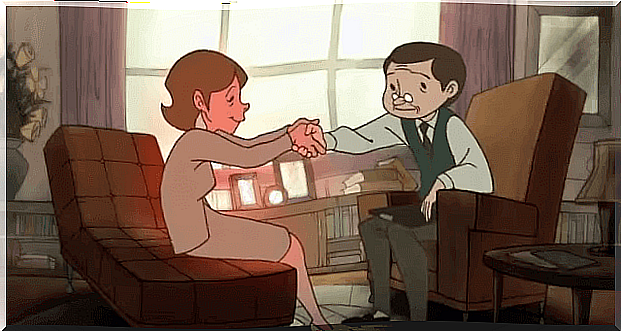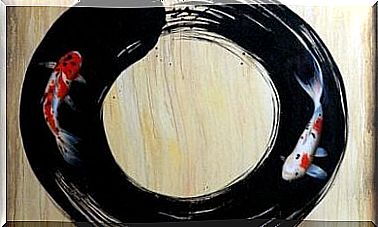Empathy Is The Thread On Which Therapy Is Woven

We have all heard of empathy, its importance in relationships, its powerful effects in communicating with others, the need to make it part of our life as something indispensable. However, few people have heard of her place in a psychotherapeutic relationship and how, without her, the therapy boat goes adrift. If it is not present, the prognosis is wrong.
The therapist’s empathy towards his / her patient is as necessary and vital for proper functioning as the air we breathe. It is a characteristic that no one can do without.
In therapy, as in life, we are also lost
In therapy, as in life, the patient very often feels lost. He feels that his life is moving forward without a very clear conductive thread. Without a powerful and visible light that guides his steps. He gropes his way forward, between the darkness of the path and the little flashes of light that appear from time to time on the side aisles.

The therapist cannot and must do nothing other than accompany him on this path. This path that, between circumstances and his will, he chose to learn the lessons of life that built him as a person. Often, we think that the job of a psychologist is to divert the person from this insecure path, on which he finds himself: to give him the motivation to move away from the moments which he must, on the contrary, live. For the benefit of its own development.
Life is sometimes uncertain and it is a reality that must be accepted
Walking in uncertainty is natural and human. However, we shouldn’t be afraid. Life is like a torrent of water changing direction, but always moving forward. It is like a current of water which sometimes turns into a fragile stream… but which on the contrary, after a big storm, regains the power of times gone by.
Even the path a river takes is uncertain. Her impulse and blind confidence in the land she floods are the driving force that leads her to continue on this precarious path. As changing as our life.

“Living is the rarest thing in the world. Most people just exist. ”
-Oscar Wilde-
In psychotherapy, it’s the same thing. The person will often feel lost. But it’s very different to feel lost in being accompanied than in being alone and without the support of anyone. However, the mere presence of the psychotherapist will not give the patient the impression of being accompanied. The patient feels accompanied to the extent that the therapist gradually hands him all the threads that the patient has entrusted to him. Having an empathetic attitude and respecting the patient’s rhythms is crucial in this process.
A nice metaphor for empathy
Here is a nice metaphor on the process of accompaniment in therapy. It is a psychologist specializing in bereavement who stated it. He said that the patient, or the person who confides his pain to the psychotherapist, throws him a series of threads. Yes, like the threads of a ball of yarn, for example. He throws at his own pace. Sometimes it takes a while and sometimes it throws them all at once.

“We must be able, for ourselves, not to be sure of ourselves, but to tolerate insecurity.”
-Erich Fromm-
The therapist therefore collects these threads that the patient throws at him, but instead of leaving them aside, he gives them back to him. Little by little, the threads cross and create a fabric. This personalized fabric will be the one that serves as a support for the patient and on which he / she can sit in the future. The tissue that the two people created is a metaphor for the therapeutic relationship.
Therapist and patient sail in the same boat
The therapeutic relationship cannot be understood without empathy. Empathy is this foundation, this wonderful fabric, on which the therapeutic process takes place. Every gesture, every emotion, every thought, every need is listened to, is understood and is delivered in a clearer, sharper and more adjusted way to the person in front of us.
The therapist is not sailing a different boat. He is on the same boat as his / her patient. And they sail together. He accompanies him on this uncertain and full of life crossing.
If the therapist does not return any of the threads the patient sends to him / her, he / she will not be able to build a relationship of trust and security with him / her. The two people will not be in harmony and the patient, far from perceiving his / her psychologist as someone close, will end up seeing him as a distant and fuzzy figure in whom he / she cannot trust, and even worse, with whom they will not feel free to be themselves.
The therapist must also listen to what is not said in words
To give back… you have to listen. But we must also listen to every movement of the patient. People speak in multiple languages. We speak with every part of our body, without necessarily saying words with our mouth. You have to listen to each of these languages.
“What does it mean to help? Help is an art. Like all art, it requires skill that can be learned and practiced. It also requires empathy with the person seeking help. In other words, you have to understand what corresponds to it and, at the same time, what transcends it and directs it towards a more global context. ”
-Bert Hellinger-
We must master this wisdom that we have never been taught in studies or in books. It is a much more subtle and intuitive language. It must be understood that the course of life also passes through these places and therapists must understand this in order to get closer to their patient. Only then will they be able to listen to them and understand them.
Understanding with empathy is essential in therapy
It is in this empathic understanding that the therapeutic relationship is configured. As Mariana Yela said in the preface to a book by Carl Rogers and Marian Kinget:
“The psychotherapist does not sanction, censor, judge or act for the patient. He does not show him any way, nor does he close his path. He lives with him his conflicts and his problems, trying to understand the personal meanings they take for the other. The patient finds nothing in what keeps him away from him or in what makes him hide his face. ”
This is why the therapeutic process is unique and personal. There are no “standard packages”, answers, or one-size-fits-all techniques. Each person is unique in themselves and therapists must systematically adjust to them. They must accompany them on this crossing which we call “life”. A crossing during which you have to accept that there are certain and less certain moments, because ultimately …
What is all this if not life?








